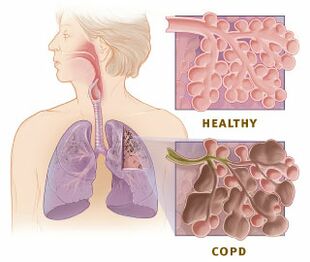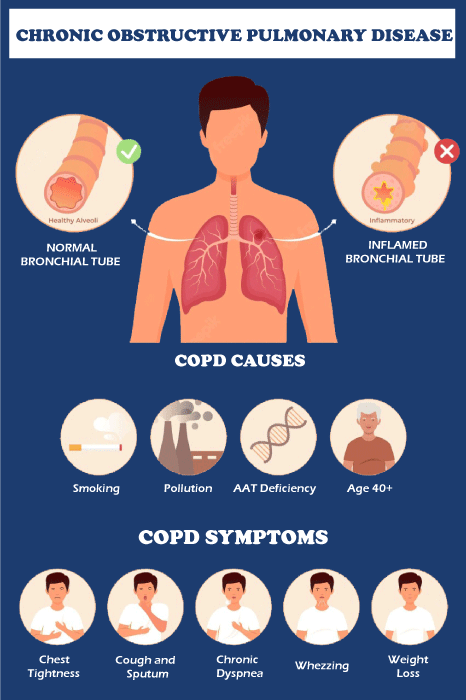What is the Full Form of COPD in Medical
COPD: Chronic Obstructive Pulmonary Disease
COPD stands for Chronic obstructive pulmonary disease. Emphysema and Chronic bronchitis are two terms generally used for COPD. Emphysema causes significant damage to the lungs and air sacs. As a result, the lungs lose their elasticity and are less efficient at exchanging carbon dioxide and oxygen. Whereas in conditions like Chronic Bronchitis, the lining of the airways is inflamed, mucus is produced in a large amount, and it is also thickened, which leads to bronchitis.

Individuals suffering from Asthma are more likely to get COPD, and symptoms of Asthma itself may confirm this disease. The airways become enlarged and cause uneasiness as something is inhaled. COPD is a persistent disease that causes irreversible lung damage as well as worsening breathing problems and respiratory failure. A person suffering from advanced COPD may be unable to climb stairs or cook. They may require prescribed medication and supplementary oxygen.
Symptoms
COPD causes various symptoms in the human body, a few of which are listed below:
- Breathlessness, especially after exercise
- Continuous cough
- Tiredness
- Wheezing
- Difficulty breathing that worsens over time
Some of the severe symptoms include:
- A bluish tint to the lips or fingernail beds
- Shortness of breath while talking
- Reduced mental alertness
- A rapid heartbeat
Anyone with such severe symptoms should immediately seek medical help.
Causes

Aside from smoking, other risk factors for COPD include:
- People who are exposed to continuous smoking.
- Access contact with pollutants and toxins at home or at the workplace, which causes Asthma.
- Access contact with pollutants and toxins at home or at work can lead to Asthma.
- Genetic factors may include the absence of protective proteins like antitrypsin.
When to seek medical advice
Consult your doctor if your symptoms do not get better or get worse after treatment or if you notice any infection-related symptoms, including a fever or a change in your sputum.
Seek immediate medical attention if you are having trouble breathing, have severe cyanosis (bluing of the lips or nail beds), have a rapid heartbeat, feel dizzy, or have trouble focusing.
Diagnosis
- Diagnosis takes into consideration individual and family medical records.
- A doctor performs a physical examination, listening to the person's breathing with a stethoscope.
- A test of lung function.
- An arterial blood test is conducted to determine the level of oxygen in the blood.
- Tests such as an X-ray or CT scan can also be used.
- Spirometry is one kind of lung function test that examines the amount and speed of flow of air during a quick breath. The person blows hard into a tube attached to a spirometer, which provides the interpretation.
Treatment
There is no such cure or treatment for COPD. The only best treatment is to manage the symptoms and improve the quality of life, reduce the risk of diseases, and take health issues seriously.
- Quit smoking- It can help to decrease symptoms of COPD and slow down its progression.
- Avoid exposure to air pollutants- People should try to avoid exposure to air pollutants as it contains harmful gases which are carcinogenic in nature.
This mainly includes:
- Open fires should be avoided
- Requesting others not to smoke nearby
- Seeking to avoid areas where individuals are spraying paint or insect repellant
- Choosing to stay at home with the windows shut when air pollution levels are high
- Covering protective gear, such as a face, when working in a dusty environment.
Medication
- Medications can help control COPD symptoms while also avoiding side effects.
- A doctor might prescribe a nasal spray that usually contains a variety of drugs to help with respiration. An inhaler, for instance, may contain a bronchodilator medicine to relax the muscles surrounding the air passages and make inhalation and exhalation easier.
- A nasal spray may also contain a glucocorticoid, a type of steroid that can decrease inflammation in the airway.
- A few inhalers are only meant for quick use. They act quickly and are only efficient for a couple of hours. They can help you breathe better during a COPD burst. Others are intended for long-term, daily use.
- Also, visiting the doctor from time to time is a must. The doctor may modify the oral medications to help manage worsening symptoms.
- They may also recommend antibiotics to combat any acute infectious disease that emerges, as well as vaccination to safeguard against pneumonia and flu viruses.
- An individual with COPD who is going to receive effective respiratory treatment may still experience repeated flare-ups that require hospital treatment.
- To decrease the number of flare-ups, the doctor might prescribe the anti-inflammatory medicine roflumilast or the antibiotic azithromycin.
Experiencing COPD
You can take daily actions to maintain your health, prevent the progression of COPD, and safeguard your lungs.
To gain strength, walk:
- How far you must walk should be discussed with the medical professional or therapist.
- Gradually increase your walking distance.
- If walking causes you to become out of breath, avoid talking.
- When you exhale, breathe through your pursed lips to clear your lungs before taking another breath.
You can do the following things around your house to make life easier for yourself:
- Avoid extremely hot or cold weather.
- Make sure no one smokes inside your house to reduce air pollution. Also, get rid of other irritants and do not use the fireplace.
- Control your stress and mood.
- If prescribed, use oxygen.
- Consume nutritious foods like fruits, vegetables, lean meat, fish, poultry, and other seafood. Speak to a healthcare professional or dietitian about eating foods with more calories if you are struggling to maintain your weight.
To treat COPD, surgery or other procedures may be used. Only a few people benefit from these surgical treatments:
- In some individuals, one-way valves can be implanted during a bronchoscopy to assist in deflating hyperinflated (overinflated) lung tissue.
- Some emphysema patients benefit from surgery to remove portions of the diseased lung, which makes the healthy lung tissue function better (lung volume reduction surgery).
- For a tiny percentage of really severe cases, lung transplant.
|


 For Videos Join Our Youtube Channel: Join Now
For Videos Join Our Youtube Channel: Join Now










